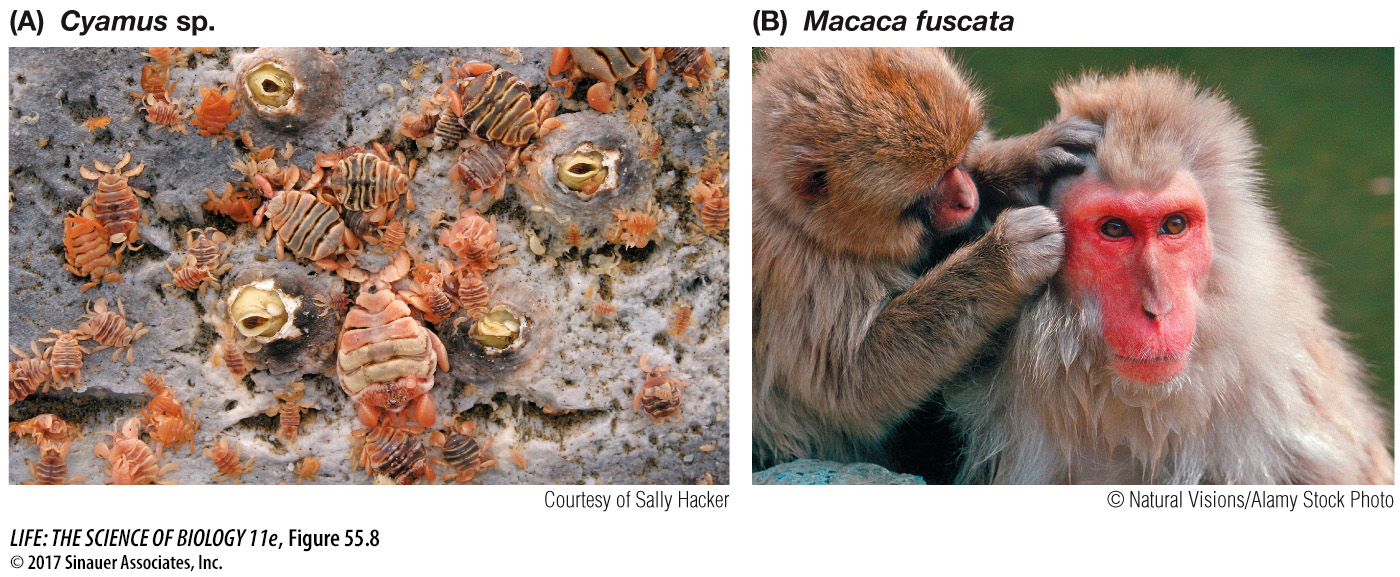Most parasites specialize on hosts, and most hosts house many species of parasites
Parasitism is an interaction in which a predator (a parasite) lives on or in the prey (its host) and consumes only certain tissues. Many parasite–

Parasites can be classified as microparasites, which include viruses, bacteria, and protists, or macroparasites, which are larger and include such groups as worms and insects.
MICROPARASITES Microparasites are many orders of magnitude smaller than their hosts and generally live and reproduce inside their hosts. Multiple generations may reside within a single individual, and a host may harbor thousands or millions of them. Many microparasites, in the process of acquiring nutrients at the expense of their host, cause symptoms of disease and thus are considered pathogens. Host mechanisms that can limit pathogen proliferation include the immune system in animals (see Chapter 41) and biochemical defenses in plants (see Key Concept 38.3).
Just as with other predator–
An example of the complex interactions between host and pathogen comes from Australia, where the myxoma virus was introduced to control the exploding population of European rabbits (Oryctolagus cuniculus), which were devastating the rangeland vegetation used by cattle and sheep. The virus, which is transmitted by mosquitos, causes infections and blindness in rabbits, eventually leading to starvation and death. After the introduction of the virus in 1950, 99.8 percent of infected rabbits died. Millions of rabbits died over the following decades, but the rabbits slowly evolved resistance to the virus. The virus is still used to control rabbit populations, but this requires introducing new, more lethal strains of the virus to ultimately be effective.
MACROPARASITES While microparasites generally live and reproduce inside their hosts, macroparasites are not always intimately associated with their hosts. Macroparasites rarely cause the same kinds of disease symptoms that pathogenic microparasites cause, but they may nevertheless affect host survival and reproduction and can thereby act as agents of selection on their hosts. Ectoparasites are macroparasites that live outside the bodies of their hosts. Endoparasites, such as the tapeworms described in Key Concept 30.4, are macroparasites that spend at least part of their life cycle inside the bodies of their hosts.
Some ectoparasites, such as leeches and mosquitoes, are only casually associated with their hosts, interacting with them just long enough to eat their fill and then moving on. Ectoparasites that spend their entire lives on their hosts have several attributes that keep them attached to their hosts. Whale lice, which are generally found in skin lesions, nostrils, and eyes of marine mammals, have claws on the tips of their legs that pierce the skin of the whale or dolphin host (Figure 55.8A). Most whale lice are associated with a single species of whale and spend their entire lives on one individual whale. The lice feed on algae or flaking skin on the whale’s body, causing minor skin damage but no significant health risks.

Most hosts actively work to rid themselves of their ectoparasites. Grooming behavior—